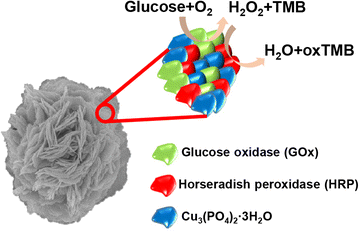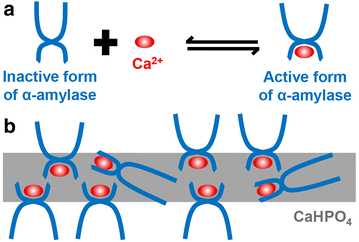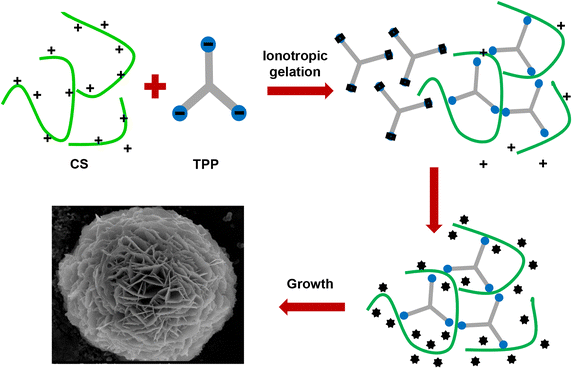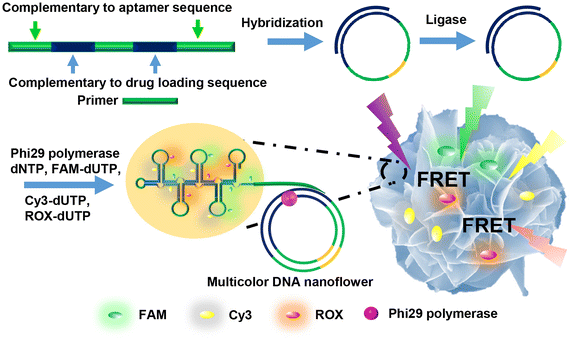Organic-inorganic hybrid nanoflowers: types, characteristics, and future prospects
- PMID: 26337651
- PMCID: PMC4559159
- DOI: 10.1186/s12951-015-0118-0
Organic-inorganic hybrid nanoflowers: types, characteristics, and future prospects
Abstract
Organic-inorganic hybrid nanoflowers, a newly developed class of flower-like hybrid nanoparticles, have received much attention due to their simple synthesis, high efficiency, and enzyme stabilizing ability. This article covers, in detail, the types, structural features, mechanism of formation, and bio-related applications of hybrid nanoflowers. The five major types of hybrid nanoflowers are discussed, i.e., copper-protein, calcium-protein, and manganese-protein hybrid nanoflowers, copper-DNA hybrid nanoflowers, and capsular hybrid nanoflowers. The structural features of these nanoflowers, such as size, shape, and protein ratio generally determine their applications. Thus, the specific characteristics of hybrid nanoflowers are summarized in this review. The interfacial mechanism of nanoflower formation is examined in three steps: first, combination of metal ion and organic matter; second, formation of petals; third, growth of nanoflowers. The explanations provided herein can be utilized in the development of innovative approaches for the synthesis of hybrid nanoflowers for prospective development of a plethora of hybrid nanoflowers. The future prospects of hybrid nanoflowers in the biotechnology industry, medicine, sensing, and catalysis are also discussed.
Figures








Similar articles
-
Ultrafast sonochemical synthesis of protein-inorganic nanoflowers.Int J Nanomedicine. 2015 Aug 25;10 Spec Iss(Spec Iss):137-42. doi: 10.2147/IJN.S90274. eCollection 2015. Int J Nanomedicine. 2015. PMID: 26346235 Free PMC article.
-
Organic-inorganic nanoflowers: from design strategy to biomedical applications.Nanoscale. 2019 Oct 7;11(37):17179-17194. doi: 10.1039/c9nr05446d. Epub 2019 Sep 18. Nanoscale. 2019. PMID: 31532431 Review.
-
Nanoflowers: the future trend of nanotechnology for multi-applications.Artif Cells Nanomed Biotechnol. 2018;46(sup1):413-422. doi: 10.1080/21691401.2018.1428812. Epub 2018 Jan 23. Artif Cells Nanomed Biotechnol. 2018. PMID: 29361844 Review.
-
Hybrid metal-organic nanoflowers and their application in biotechnology and medicine.Colloids Surf B Biointerfaces. 2019 Oct 1;182:110354. doi: 10.1016/j.colsurfb.2019.110354. Epub 2019 Jul 13. Colloids Surf B Biointerfaces. 2019. PMID: 31325775 Review.
-
Protein-inorganic hybrid nanoflowers.Nat Nanotechnol. 2012 Jun 3;7(7):428-32. doi: 10.1038/nnano.2012.80. Nat Nanotechnol. 2012. PMID: 22659609
Cited by
-
Ciprofloxacin Functionalized Biogenic Gold Nanoflowers as Nanoantibiotics Against Pathogenic Bacterial Strains.Int J Nanomedicine. 2019 Dec 17;14:9905-9916. doi: 10.2147/IJN.S224488. eCollection 2019. Int J Nanomedicine. 2019. PMID: 31908448 Free PMC article.
-
Surfactant-activated lipase hybrid nanoflowers with enhanced enzymatic performance.Sci Rep. 2016 Jun 14;6:27928. doi: 10.1038/srep27928. Sci Rep. 2016. PMID: 27297609 Free PMC article.
-
Green biotransformations catalysed by enzyme-inorganic hybrid nanoflowers in environmentally friendly ionic solvents.Environ Sci Pollut Res Int. 2018 Sep;25(27):26707-26714. doi: 10.1007/s11356-017-9271-3. Epub 2017 Jun 8. Environ Sci Pollut Res Int. 2018. PMID: 28597383
-
Recent advancements in enzyme-incorporated nanomaterials: Synthesis, mechanistic formation, and applications.Biotechnol Bioeng. 2022 Oct;119(10):2609-2638. doi: 10.1002/bit.28185. Epub 2022 Jul 29. Biotechnol Bioeng. 2022. PMID: 35851660 Free PMC article. Review.
-
A systematic review of nanocarriers used in medicine and beyond - definition and categorization framework.J Nanobiotechnology. 2025 Feb 7;23(1):90. doi: 10.1186/s12951-025-03113-7. J Nanobiotechnology. 2025. PMID: 39920688 Free PMC article.
References
-
- Lattuada M, Hatton TA. Synthesis, properties and applications of Janus nanoparticles. Nano Today. 2011;6(3):286–308. doi: 10.1016/j.nantod.2011.04.008. - DOI
-
- Kim J, Grate JW. Single-enzyme nanoparticles armored by a nanometer-scale organic/inorganic network. Nano Lett. 2003;3(9):1219–1222. doi: 10.1021/nl034404b. - DOI
Publication types
MeSH terms
Substances
LinkOut - more resources
Full Text Sources
Other Literature Sources

